How a Santa Barbara boat trip got me hooked on the thrill of deep-sea fishing

- Share via
It felt like a Vegas casino at 3 a.m., except instead of full houses, people were flashing fish the color of fire.
A voice blared over a loudspeaker something to the effect of, “Could this be the jackpot you’ve been waiting for?”
You are reading The Wild newsletter
Sign up to get expert tips on the best of Southern California's beaches, trails, parks, deserts, forests and mountains in your inbox every Thursday
You may occasionally receive promotional content from the Los Angeles Times.
Something jerked my own fishing line dangling more than 400 feet below the shiny ocean surface. I furiously spun my reel with my right hand. “What will it be? What will it be?” I wondered with the fervor of a gambler.

An orange-red rockfish with bulging eyes emerged from the deep as I strained with all my might to keep hauling it up. A man next to me half-jokingly commented on my audible “grunting.”
When I‘d stepped onto the Coral Sea, a boat operated by Stardust Sportfishing as the day broke beautifully over the Santa Barbara Harbor in late December, I‘d been seized with anxiety that I might spend the day trying to tie on a hook. Hours later, I was stuffing my seventh fish into a burlap sack.
Before you get any ideas, I am not a deep-sea-fishing savant. My success was almost entirely due to the help of the crew members who cheerfully walked me through all the steps, from getting the rod set up to casting to reeling.
Tyler Cross, a sandy haired, youthful crew member, even showed me how to hold up a rockfish without hurting my hand — a difficult task if you’ve ever tried to handle one of the spiky creatures.
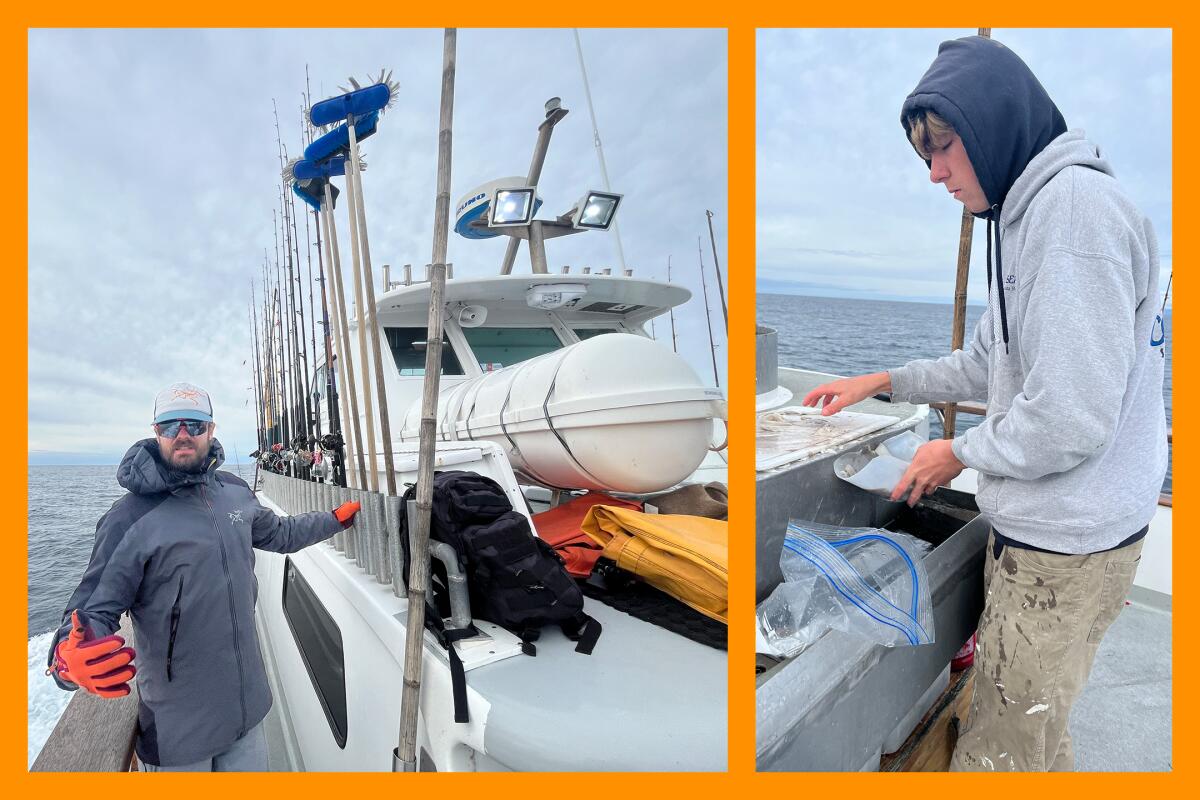
An old friend of mine, Sandy Ku, extolled the joys of deep-sea fishing for years, but it never intrigued me. That is until another friend, Victoria Ferriz, posted pictures of the blazing orange-red fish on Instagram. I was — pardon the terrible pun — hooked on the idea of giving it a go.
We — Ferriz, Ku and my partner — were able to book one of the last trips of the season that includes angling for rockfish, a term that encompasses several species with a penchant for hiding among rocks. The vermilion rockfish is recognizable by its vivid red color, but others are brown, blue, gray. Some boast tiger stripes or dorsal fins that resemble porcupine quills.
Arriving at the Santa Barbara Landing at 6 a.m., venti Starbucks coffee in hand, my partner and I rented rods and bought one-day fishing licenses and hooks from a store on the landing.
On the boat, crewmember Dave Siordia informed us that we would be heading out to San Miguel Island, the farthest away of the Channel Islands. It was rare, Siordia said, to get cooperative-enough weather to make the roughly eight-hour round-trip (not including fishing time).
The moody overcast morning cleared. Dolphins skipped happily alongside the boat, always eluding my camera. I felt a strange elation to be sandwiched between the endless blue plains of sky and sea. A coming storm ushered in a large swell. We heaved over mounds of water. Then, I was heaving — over the side of the boat.
I was worried my sea sickness would count me out for the day. But as soon as the boat stopped at our first fishing spot, I was back in action. My line went down and jerked — a bite on my first cast-off. As Siordia instructed, I stuck the butt of the reel under my left arm and cranked with all my might. When my first catch emerged from the waves, a crewmember unhooked it and chucked it into my sack.
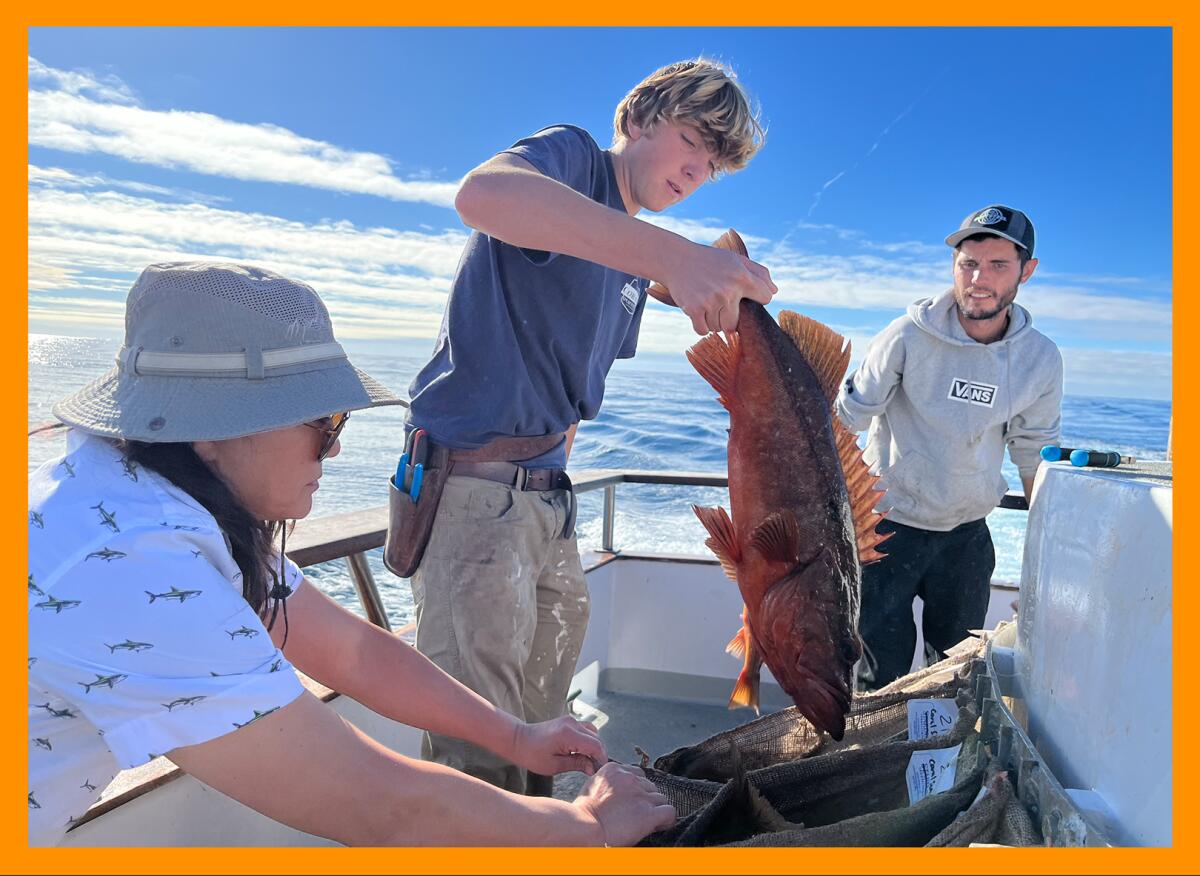
As we reeled up our lines from depths between roughly 300 and 400 feet, we didn’t know what we’d get. There were two hooks per line, and sometimes a pair of fish came up simultaneously. Siordia called these “double doubles.” One man hooked a sole, sparking unanimous jealousy. Ku pulled up an enormous lingcod. It turned out to be the heftiest catch of the day.
At our last (and deepest) fishing spot, the fish bit like mad. I sensed a collective relaxation. Everyone’s sack was brimming with fish, and now it seemed they could unwind. Beers were cracked open. I mauled a cheeseburger.
It’s “something to take you out of your regular 9 to 5,” said Hyung Lee, 32, of Thousand Oaks, who had come with his 8-year-old daughter, Romy. It was both of their first times, and Romy seemed to be holding up miraculously well, considering the trip lasted nearly 12 hours. She shyly told me that she‘d had fun, and her father described the experience as “very special.”
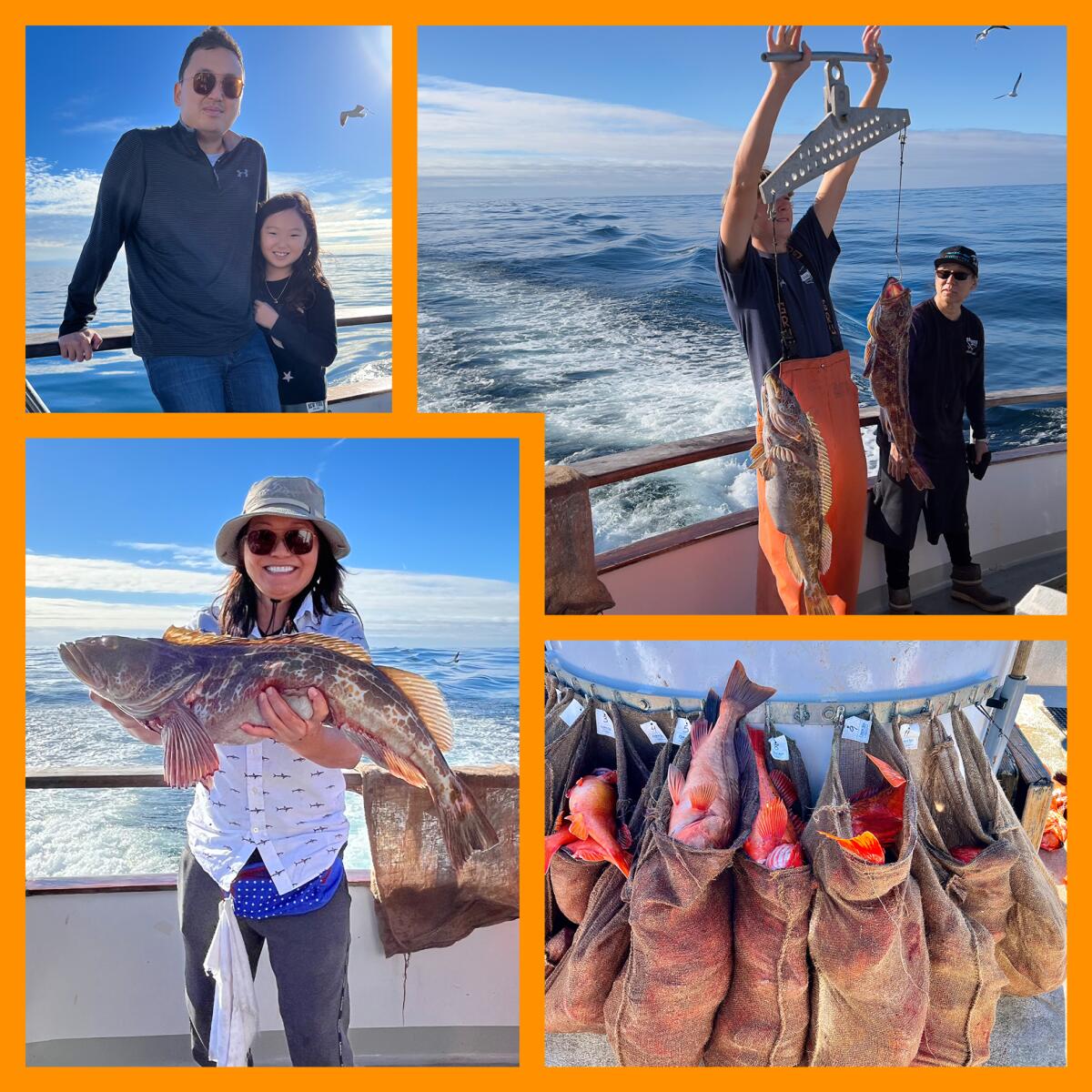
The fun comes at a price. With boat ride ($140 plus fees) and all the other add-ons (including bait, fish-cleaning, on-board food and parking), it came to about $250 per person.
Still, it felt satisfying to unload our ichthyic booty — about 20 rockfish — at home later that night. My partner deftly filleted one of the fish and pan fried it in butter. From sea to skillet in 14 hours — the freshest fish I’ve ever eaten.
From January through March, interested anglers can join Stardust’s weekend trips that board at 9 a.m. and return at 3 p.m. (plan on arriving at the dock an hour before departure). Half-day boat tickets — that don’t include the cost of incidentals — are $85 for adults and $70 for juniors and seniors.
Other boats managed by different companies are located along the coast, including landings in Ventura, Oxnard, Marina del Rey, San Pedro, Long Beach, Newport Beach, Dana Point, Oceanside, San Diego and Morro Bay.
3 things to do
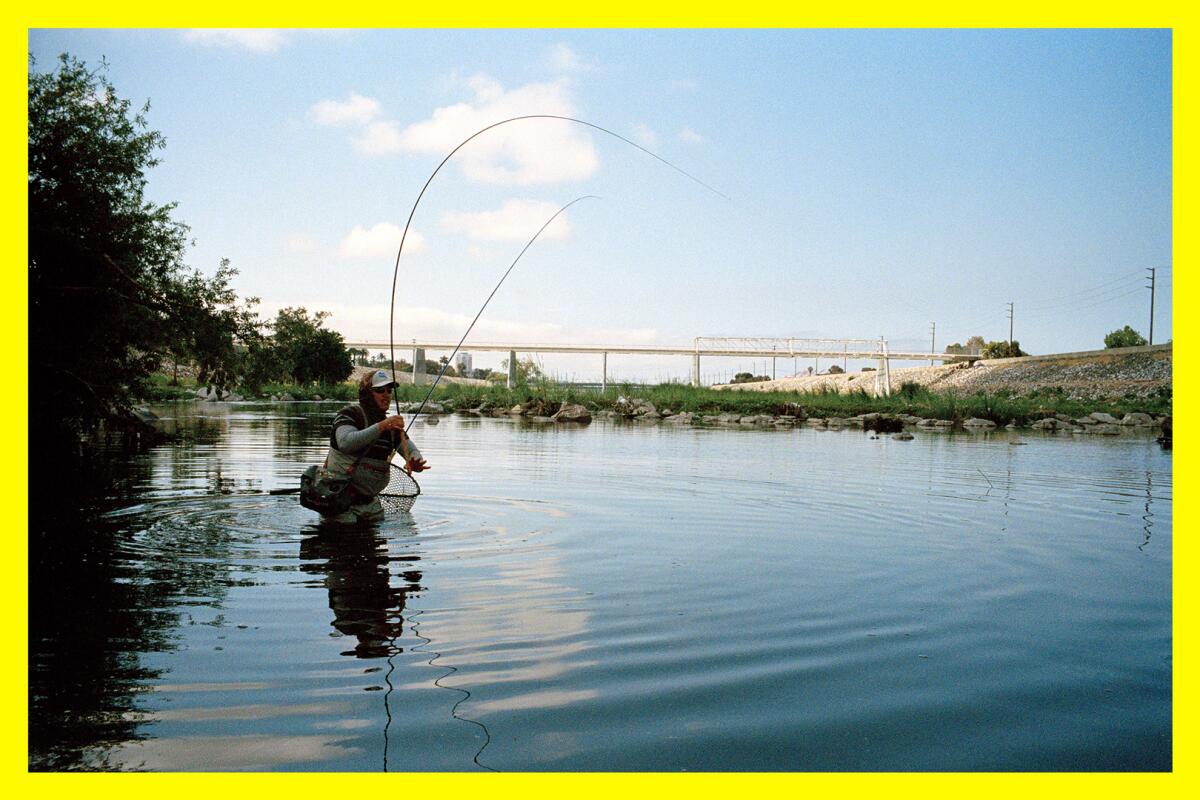
1. Fish the L.A. River. Before you recoil in horror, hear me out: deep-sea fishing is exhilarating but a schlep if you don’t live near the water. And many people find half the fun of fishing is hanging out with friends or family while you cast away. Angelenos with a rod and other fishing essentials can tap into the togetherness at their local river.
Despite the river’s concrete casing, installed in the late 1930s to rein in once-frequent flooding, signs of the natural stream persist. Besides birds of many feathers, it’s also home to beefy carp, small-mouth bass and tilapia.
In 2020, I interviewed Omar Reyes and several other anglers along a stretch of the river near the hip enclave of Frogtown. Reyes, who was spending an idyllic day fishing with his two children, told me, “It takes everything away from you — all the problems, all the stress.”
Most L.A. River anglers release their catch, but some brave souls (and journalists) have dared a nibble. A 2019 L.A. Times article includes a recipe for Los Angeles River Backyard Carp Larb, adapted from a cookbook by the chef-owner of Night + Market restaurants. Those 16 and older need a sport fishing license to legally cast in the river. To buy one, visit wildlife.co.gov.

2. Join a guided hike and stretch with ocean views. You don’t need to hit the open water to enjoy Southern California’s breathtaking coastline. On Jan. 20, outdoor gear supplier REI is hosting a guided four-mile hike followed by a 60-minute yoga session at Orange County’s Crystal Cove State Park. The hike will cover a roughly 600-foot (total) elevation gain and loss and take participants past picturesque vistas of the Pacific Ocean. After the cardio, yoga will begin on the beach. According to the organizers, the yoga class will center on “caring for our hiking muscles and full body.”
Participants don’t need prior experience to join but must be 16 years or older. The outing costs $109 for REI members and $139 for nonmembers. If you can’t make it this weekend, there are also sessions scheduled for February and March. Tickets at rei.com.

3. Peek into the lens of a “kayak photographer.” For 26 years, author and lifeguard Chuck Graham has led kayaking tours around the Channel Islands off Ventura, and the archipelago renowned for its pristine nature is at the forefront of his latest book. “Paddling Into a Natural Balance” features stories about kayaking and conservation efforts that Graham witnessed from his vessel — as well as 170 photos. According to a news release, Graham was inspired to create the “ode” to Channel Islands National Park after snapping photos of a bald eagle on the cliffs around a harbor on the largest of the islands.
On Jan. 26, Graham will mark the release of the book with a lecture and book-signing at the California Nature Art Museum (formerly the Wildling Museum) in Solvang. The event will run from 4:30 to 6 p.m., and books ($40) will be available for purchase onsite. Tickets are $5 for members and $10 for nonmembers and can be purchased at wildlingmuseum.org.
The must-read

Zuko Carrasco was seized with despair after a climbing accident he describes as “stupid” left him paralyzed from the waist down. As a longtime mountain guide in his native Ecuador as well as Argentina, he wondered how he could provide for his family, including a daughter born just a week before the life-changing event in 2015. In a poignant piece published last week, my colleague Jack Dolan masterfully recounts how Carrasco clawed himself out of the depths of depression and back into the driver’s seat of an adventurous life.
In October, Carrasco even summited the sheer 3,000-foot granite face of El Capitan in Yosemite National Park — a feat beyond the capacity of many experienced climbers. To make the momentous ascent, Carrasco and his team rigged ropes with a specially designed pulley system. Carrasco then largely pulled himself up, arduously, slowly. When flooded with doubt, he took in the grandeur around him. “What saved me was just being there and enjoying the view,” he said. “Taking my time, breathing and enjoying the world.”
Happy adventuring,

P.S.
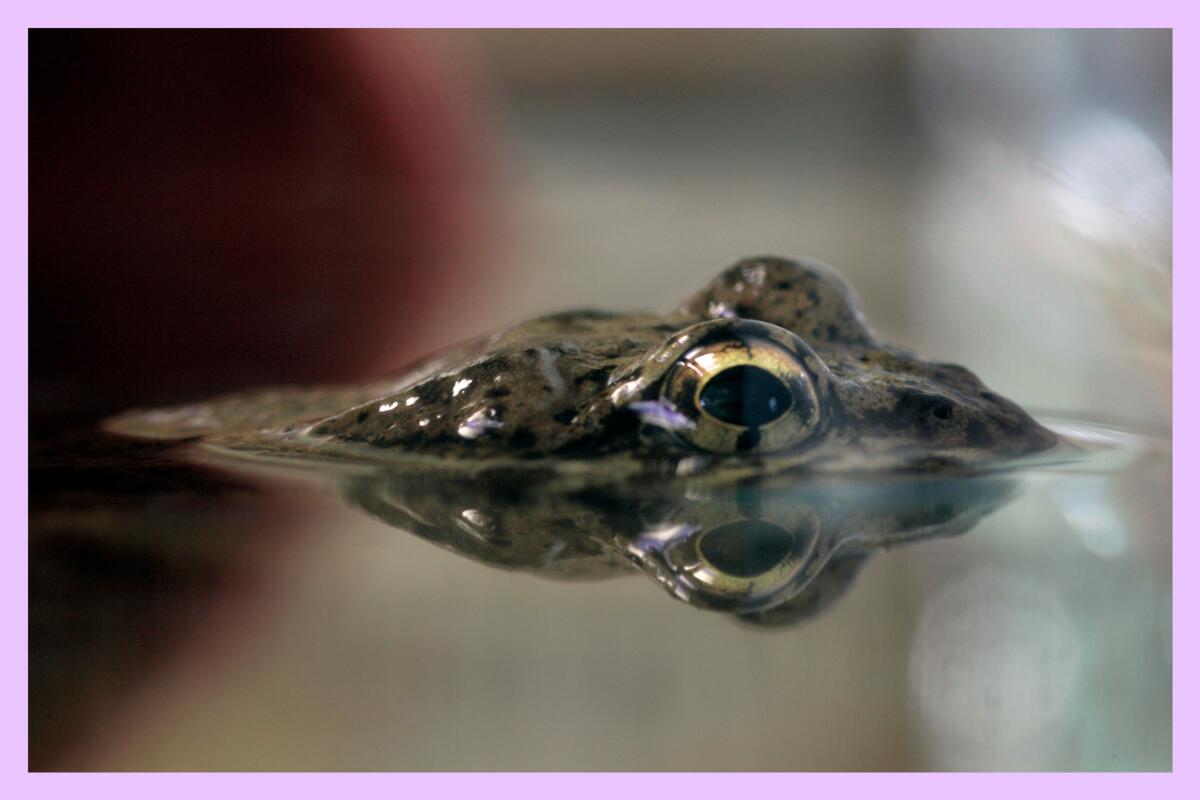
Ever wonder where frogs spend their winter vacations? In California, chilly weather signals hibernation for black bears — and, apparently, frogs. Many of the state’s 27 native toads and frogs hunker down in frigid weather, according to the California Department of Fish and Wildlife. While amphibians hibernate, their heart rate and metabolism slow way down, freeing them from the need to chow down on food.
When the long snooze starts depends on what elevation the frogs live at, with those living higher up hibernating longer than those lower down, the state agency said in a recent outdoors column. Some of them take refuge in water, while others remain on land.
Among the amphibians getting prolonged shut-eye are Southern California mountain yellow-legged frogs, a federally endangered species once rampant in local mountains. “To escape frigid weather, the frogs take shelter in underwater rock crevices and submerged vegetation located in deep pools, which are less likely to freeze over,” the department wrote in the column.
For more insider tips on Southern California’s beaches, trails and parks, check out past editions of The Wild. And to view this newsletter in your browser, click here.
Sign up for The Wild
We’ll help you find the best places to hike, bike and run, as well as the perfect silent spots for meditation and yoga.
You may occasionally receive promotional content from the Los Angeles Times.




